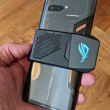[OLD] Review: Google Pixel 2 XL
Oct 23, 2017, 2:47 PM by Eric M. Zeman
updated Nov 15, 2017, 3:09 PM
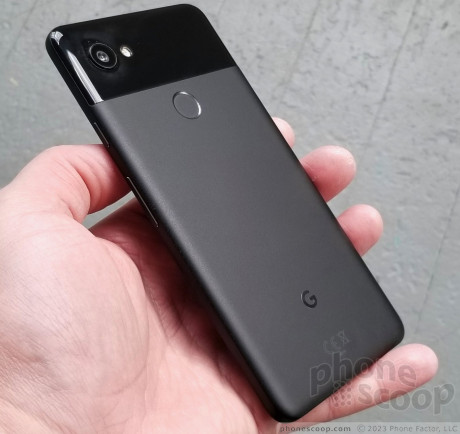
The Pixel 2 XL from Google is a high-end handset that includes a powerful camera, a big screen, a metal design, and a pure Google experience that comes with the promise of speedy software updates. It represents what Google thinks Android is all about. But there's a big problem facing the Pixel 2 XL, Google, and its fans, that we think is worth addressing directly.
This article has been replaced by a full review of the phone with updated software.
Background
This isn't going to be a normal, in-depth review of the Google Pixel 2 XL. I've used the phone for a number of days now, and — though there's much to like about this device — the device shipping at the moment suffers from a critical flaw that prevents me from recommending it to anyone. In the interest of saving readers some time and cutting right to the chase, we're offering an abbreviated assessment of the Pixel 2 XL and why you simply should not buy it right now.
Screen
Let's start with some basics. The screen measures 6 inches across the diagonal with 2,880 by 1,440 pixels and a 2:1 (or 18:9, if you prefer) aspect ratio. The screen is an OLED panel, as opposed to LCD, and LG protects it with Gorilla Glass 5. It should provide us with the same great experience we saw on the LG V30, but it doesn't.

First, color: OLED and LCD panels handle color differently, though each can be tuned by the manufacturer to some degree. In general, LCD panels offer a more accurate approach to color. I've long been impressed by LG's LCD panels. So has Apple, as the iPhone maker often relies on LG to manufacture iPhone and iPad screens. OLED panels tend to oversaturate colors. This makes them pop more visually and offer near perfect blacks. This comes at the expense of accuracy. It's a bit of a give or take, and something that may boil down to personal preference.
The Pixel 2 XL uses an OLED panel that Google says it tuned to be more accurate, (as opposed to visually impressive at first glance.) In a statement provided to The Verge, Google explained, "We designed the Pixel display to have a more natural and accurate rendition of colors this year but we know some people prefer more vivid colors so we've added an option to boost colors by 10% for a more saturated display. We're always looking at people's responses to Pixel and we will look at adding more color options through a software update if we see a lot of feedback."
True enough, the Pixel 2 XL's OLED screen is more muted when compared to other OLED panels. I held it next to the V30, (which uses a very similar panel from the same supplier,) and it's clearly not as bright, nor as oversaturated. The same is true when comparing the V30 to the Note8, which also uses OLED. The colors are less vivid on the 2 XL and, in turn, more true to real-life. This is particularly apparent when you look at photos of people or colorful objects. It's not as obvious when looking at web pages or apps that have busy designs.
As for the phone's "color boost" toggle, I can't see any difference at all when I toggle the button on/off.
There's no question the 2 XL's screen is less "impressive" than those of the V30 or Note8, but I think a case can be made for user preference here.

Second, viewing angles: I test viewing angles on every phone I review. What I'm looking for when I do this is a change in color and/or brightness. Most often, if there's any change at all, I'll see whites turn blue in addition to a small drop in brightness. This is referred to as blue shift. Some phones have minimal blue shift and others have more; some exhibit blue shift at the smallest change in angle and others don't until you've tilted the phone practically sideways. Traditionally, OLED panels have better viewing angles than LCD panels.
The Pixel 2 XL has some of the worst viewing angles I've ever seen, even though it uses OLED technology. The display turns blue (really blue!) at the slightest change in viewing angle. Tilt it just a bit left or right and half the screen suddenly skews cold. This is most obvious when you're using an app with a white background, such as Gmail, Chrome, or myriad others. I find it utterly distracting. The same is true if you tilt the top or the bottom of the phone toward you, which is unusual. It's horribly unappealing to my eyes. It's like a shadow falls across the screen every time you adjust your grip on the phone.
Blue Shift
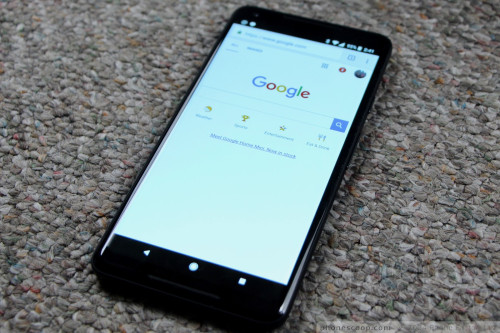
(Please note, these issues are *really* hard to duplicate on video or images. It's much more obvious in person.)
Again, I pitted the 2 XL directly against the V30 and Note8 to check viewing angles. Both the LG and Samsung have far superior performance in this respect. They do show some blue shift, but it's minimal when compared to the 2 XL. I can't fathom why there would be such a huge difference.
2 XL v. V30 v. Note8
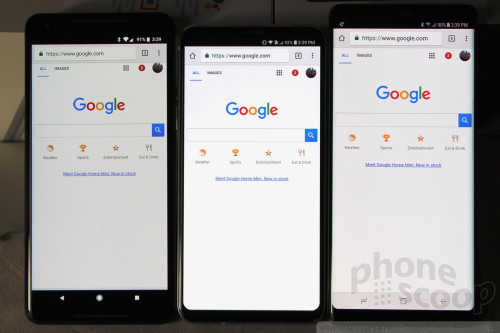
Third, burn-in: Burn-in is a longstanding issue with OLED panels (and plasma TVs). Basically, pixels that remain illuminated for a long period of time experience slightly altered chemistry compared to pixels that remain dark, and this affects the brightness and/or color of each pixel. This can leave a "ghost" image that's visible even when consuming other content.
Early prototypes of OLED technology suffered bad burn-in. OLED didn't become a common technology for full-color displays until this issue was (mostly) solved. Some modern OLED screens will still succumb to minor burn-in of persistent elements such as the status bar (clock, battery indicator, etc.) after a year or so. But OLED panels have improved dramatically in recent years and burn-in shouldn't be a major problem on any modern smartphone. Somehow, it is on the Pixel 2 XL.
Over the weekend, Android Central reported some burn-in on its Pixel 2 XL review unit. The burn-in occurred at the bottom of the display, where the on-screen navigation buttons are positioned. Other reviewers began noticing the same issue on their devices.
That's some pretty wild OLED burn-in on the Pixel 2 XL after maybe 7 days of full-time use pic.twitter.com/EPJTs6D0Kg
— Alex Dobie (@alexdobie) October 22, 2017
We did too. The burn-in on our Pixel 2 XL is absolutely minimal at this point. In fact, it's so faint we can hardly see it, but it's definitely there. The problem is that we've only used the phone for just a few days. How bad will the burn-in get after a month, 3 months, a year? We can only imagine.
I've been testing the LG V30 and Samsung Galaxy Note8 for close to two months. Neither phone's OLED panel exhibits even the slightest bit of burn-in anywhere. So why does the Pixel 2 XL, after just days?
When asked for comment, Google said, "We put all of our products through extensive quality testing before launch and in the manufacturing of every unit. We are actively investigating this report." For a phone that's barely more than a week out of the gate, Google is already assessing user feedback concerning the display's color and now burn-in.
Of these three issues, burn-in is likely the most significant. If you care to read comment threads around the internet, you'll find an equal number of people who don't care about the Pixel 2 XL's color and blue shift issues as those who do care. Burn-in is another story altogether and points to deeper problems.
Discussion
Speaking on a personal level, the Pixel 2 XL is my dream phone on paper. It boasts all the specs and design ideas I want encapsulated into a single handset. Other than the lack of wireless charging, it nails almost everything. The software is the best I've seen, the camera is super impressive, and I've never experienced a phone this quick before.
Despite all that it has going for it, the Pixel 2 XL's screen issues give me grave cause for concern. How is it possible that this display performs so much differently (and better!) on the V30? What's going on with those viewing angles, and why is burn-in happening at all on brand-new hardware? If it were just the colors, or just the viewing angles, I'd tell you to go to a Verizon store and take a good look at the Pixel 2 XL before buying. But add the burn-in issue, I'm not convinced the Pixel 2 XL is a safe purchase for anyone right now.
As much as I want to tell Google fans to run out and buy this phone, I simply can't. You will regret it, to the tune of $850. I've seen better screens on $100 prepaid phones. If you're pining for a Pixel right now, perhaps look at the smaller Pixel 2. Its OLED screen is much smaller, but doesn't have any of the XL's problems. Otherwise, I advise everyone interested in this phone to wait until Google has a firm answer — and solution — to the screen issues that are being widely reported.
We hope that Google can address these screen issues. If so, we look forward to reviewing the revised hardware in full.
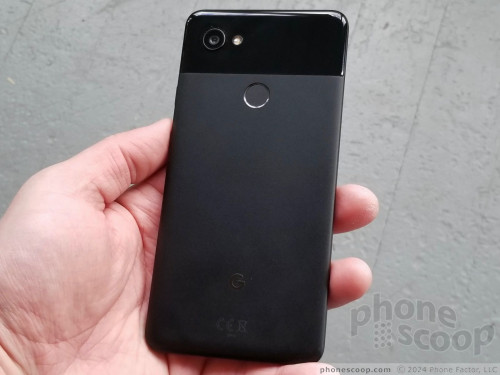
Comments
A first for PhoneScoop


 Hands On with Android P
Hands On with Android P
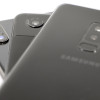 Smartphone Camera Shoot-Out: iPhone X, Pixel 2 XL, Galaxy S9+
Smartphone Camera Shoot-Out: iPhone X, Pixel 2 XL, Galaxy S9+
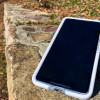 Review: Tech 21 Evo Check Case for Pixel 2 XL
Review: Tech 21 Evo Check Case for Pixel 2 XL
 Holiday Gift Guide 2017
Holiday Gift Guide 2017
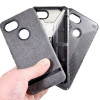 Review: UAG, Speck, and Incipio Cases for the Google Pixel 2 XL
Review: UAG, Speck, and Incipio Cases for the Google Pixel 2 XL
 Google Pixel 2 XL
Google Pixel 2 XL


